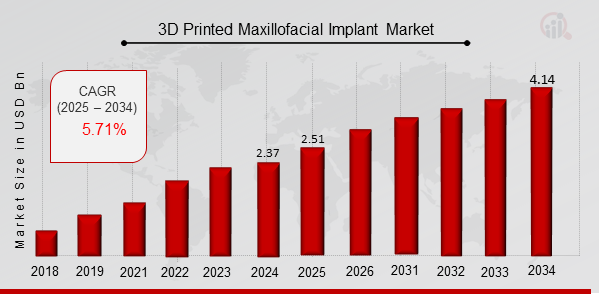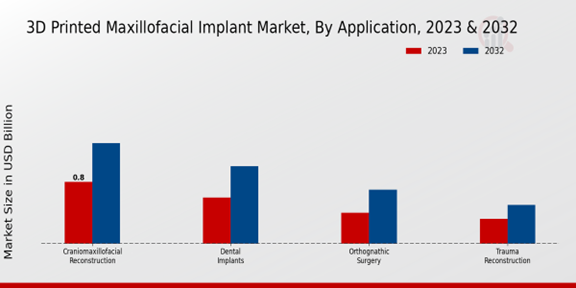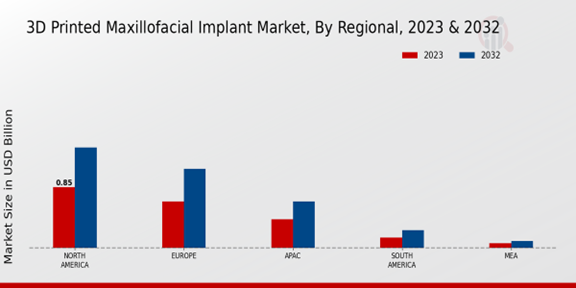3D Printed Maxillofacial Implant Market Overview
As per MRFR analysis, the 3D Printed Maxillofacial Implant Market Size was estimated at 2.37 (USD Billion) in 2024. The 3D Printed Maxillofacial Implant Market Industry is expected to grow from 2.51 (USD Billion) in 2025 to 4.14 (USD Billion) till 2034, at a CAGR (growth rate) is expected to be around 5.71% during the forecast period (2025 - 2034).
Key 3D Printed Maxillofacial Implant Market Trends Highlighted
The 3D Printed Maxillofacial Implant Market is gaining traction due to several key market drivers. The increasing prevalence of facial deformities, accidents, and tumors requiring reconstructive surgery fuels the demand for customized implants. Advancements in 3D printing technology enhance the precision and personalization of implants, making them more appealing to both patients and healthcare providers. Additionally, growing awareness of the benefits of biocompatible materials in surgical procedures contributes to market growth, as these materials reduce the risk of complications and improve recovery times. The ability to create patient-specific solutions cost-effectively also supports the widespread adoption of 3D printed implants.
Opportunities in this market are abundant, especially for companies willing to innovate. The integration of artificial intelligence and digital modeling into the design and manufacturing processes can further enhance the customization of implants. Collaborations between technology companies and medical institutions present avenues for research and development, fostering improved product offerings and expanding market reach. The expanding application of 3D printing in emerging markets provides a new customer base as developing regions seek advanced medical solutions. Education and training programs focused on 3D printing technologies will ensure that professionals are equipped to utilize these innovations effectively.Recent trends show a notable shift towards the use of bioactive materials in 3D printing for maxillofacial applications. These materials promote better integration with the patient's body, ultimately improving surgical outcomes. Moreover, the growing trend of minimally invasive surgical techniques paired with 3D-printed implants enhances recovery experiences for patients, making procedures less daunting.
With a focus on sustainability, the industry is also exploring eco-friendly materials and processes, responding to a rising demand for environmentally conscious practices in healthcare. This evolving landscape is a testament to the vibrant growth potential within the 3D Printed Maxillofacial Implant Market as innovations continue to reshape patient care and surgical practices.

Source: Primary Research, Secondary Research, MRFR Database and Analyst Review
3D Printed Maxillofacial Implant Market Drivers
Advancements in 3D Printing Technology
The evolution and continuous advancement of 3D printing technology are significantly driving the 3D Printed Maxillofacial Implant Market Industry forward. Innovations such as increased printing speed, enhanced material properties, and improved precision allow for the production of complex maxillofacial implants tailored to individual patient needs. As the technology matures, it enables manufacturers to create implants that not only improve the quality and effectiveness of surgical procedures but also reduce the time required for both production and surgery.
This versatility in design offers craniofacial surgeons better tools to work with, orchestrating a more effective and safer surgical outcome for patients with maxillofacial defects. Given the increasing adoption of personalized medicine, the ability to customize implants to fit the unique anatomy of individual patients is paramount, and thus, the 3D Printed Maxillofacial Implant Market Industry stands to benefit immensely as healthcare systems seek more efficient, tailored solutions.Furthermore, as research progresses, the development of biocompatible materials that can be easily printed and integrated into the human body is expected to enhance the reliability and success rates of these implants. As a result, the continuous integration of cutting-edge technologies will likely facilitate market growth, driving the industry toward a future characterized by innovation and improved patient outcomes.
Increasing Demand for Customized Implants
The rising demand for customized maxillofacial implants is a crucial driver for the 3D Printed Maxillofacial Implant Market Industry. Medical professionals increasingly recognize the importance of personalized treatment plans, particularly in conditions requiring surgical intervention. The ability to create implants that are specifically tailored to the anatomical structures of each patient leads to improved compatibility, better healing times, and overall enhanced surgical results.Surgeons are leveraging 3D printing to manufacture prosthetics and implants that fit the specific contours and requirements of the patient's injury or condition, thereby optimizing the functional and aesthetic outcomes. Additionally, patient satisfaction is enhanced when their treatment is individualized, creating a positive feedback loop that promotes further innovation in the market.
Growing Incidence of Maxillofacial Disorders
The increasing prevalence of maxillofacial disorders, driven by factors such as accidents, congenital conditions, and diseases, is propelling the growth of the 3D Printed Maxillofacial Implant Market Industry. With a notable rise in the population and changing lifestyles leading to a higher number of traumatic injuries, the need for effective and advanced treatment options is crucial. The adoption of 3D-printed implants is set to meet this rising demand efficiently, providing effective solutions to restore functionalities and aesthetics in patients suffering from such conditions.Furthermore, as awareness about advanced treatment methods grows among healthcare providers and patients alike, the implementation of 3D printing technology in maxillofacial surgeries is expected to become increasingly common, thereby driving market expansion.
3D Printed Maxillofacial Implant Market Segment Insights:
3D Printed Maxillofacial Implant Market Application Insights
The 3D Printed Maxillofacial Implant Market, valued at 2.12 USD Billion in 2023, presents a diverse range of applications, delineating critical opportunities within the healthcare sector.
Notably, the segment concerning Craniomaxillofacial Reconstruction represents a significant share, achieving a valuation of 0.8 USD Billion in 2023 and expected to grow to 1.3 USD Billion by 2032, thereby indicating its dominance due to rising incidences of trauma and congenital disabilities that necessitate intricate bone reconstruction procedures. The
Dental Implant application follows closely, reflecting a market size of 0.6 USD Billion in 2023 and projected expansion to 1.0 USD Billion in 2032, highlighting the increasing acceptance of 3D printing technology in enhancing the accuracy and customization of dental prosthetics.Orthognathic Surgery, with a market valuation of 0.4 USD Billion currently, is expected to reach 0.7 USD Billion by 2032. This segment emphasizes not just aesthetic improvement but critical functional corrections for patients with jaw discrepancies, showcasing its importance in holistic healthcare solutions. Meanwhile, the Trauma Reconstruction segment, valued at 0.32 USD Billion in 2023, is anticipated to grow to 0.5 USD Billion in 2032, often essential for emergency medical scenarios where immediate reconstructive options are required. Overall, the expected market growth in these application sectors indicates a sustained focus on technological innovation and the increasing incorporation of 3D printing capabilities.As a result, the continuing advancements tailored towards customization, precision, and efficiency underscore the overall market trends associated with the 3D Printed Maxillofacial Implant Market revenue, which is a clear reflection of the industry's evolution toward meeting patient-specific demands. The interplay between these distinct applications contributes significantly to the overall landscape as the potential for enhanced patient outcomes and operational efficiencies becomes ever more critical in healthcare settings.

Source: Primary Research, Secondary Research, MRFR Database and Analyst Review
3D Printed Maxillofacial Implant Market Material Insights
The 3D Printed Maxillofacial Implant Market, specifically focusing on the Material segment, has shown promising growth patterns, valued at 2.12 USD billion in 2023. As the market evolves, materials such as Titanium have gained prominence due to their strength and biocompatibility, making them suitable for a wide range of maxillofacial applications. Similarly, Polyoxymethylene (POM) is increasingly recognized for its low friction and high durability, which enhances the performance of implants. Polyether Ether Ketone is notable for its excellent chemical resistance and mechanical properties, effectively serving the needs of complex maxillofacial surgeries.Glass-ceramics contribute significantly to aesthetic demands in implants, being favored for their clarity and similarity to natural bone. These materials collectively shape the market dynamics, with each playing a crucial role in meeting both functional and cosmetic requirements, reflected in the overall 3D Printed Maxillofacial Implant Market revenue projections of reaching 3.5 USD billion by 2032. The market growth is driven by advancements in 3D printing technology, increasing incidences of traumatic injuries, and a rising demand for personalized medical solutions.However, challenges remain, such as regulatory hurdles and the need for extensive material testing, which may impact market momentum.
3D Printed Maxillofacial Implant Market Technology Insights
The 3D Printed Maxillofacial Implant Market, valued at 2.12 billion USD in 2023, is witnessing significant developments within its Technology segment. This sector is primarily driven by advancements in techniques such as Stereolithography, Selective Laser Sintering, Fused Deposition Modeling, and Computer-Aided Design.
Each of these technologies plays a crucial role, facilitating the creation of highly precise and customized implants that enhance patient outcomes. Stereolithography stands out for its rapid prototyping capabilities and fine-detail resolution, making it valuable in producing intricate designs.Meanwhile, Selective Laser Sintering is notable for its efficiency and ability to utilize various materials, which supports greater flexibility in implant design. Fused Deposition Modeling contributes significantly due to its cost-effectiveness and simpler tooling requirements. Computer-aided design is integral for producing highly detailed digital models, ensuring accuracy that enhances the overall efficiency of the implant production process. As the market continues to evolve, these technological advancements address the growing demand for personalized medical solutions, thereby driving the growth of the 3D Printed Maxillofacial Implant Market.
3D Printed Maxillofacial Implant Market End-Use Insights
The 3D Printed Maxillofacial Implant Market is positioned to see significant revenue growth within its End Use segment, which includes Hospitals, Dental Clinics, and Ambulatory Surgical Centers. In 2023, the overall market was valued at 2.12 billion USD, reflecting an increasing demand for customized solutions in maxillofacial procedures. Hospitals are a major player in this market due to their advanced infrastructure and capability for complex surgeries, thus contributing a large share of the market. Dental Clinics play a significant role as well, as more patients seek individualized dental implant solutions, growing the need for innovative maxillofacial products.Furthermore, Ambulatory Surgical Centers are gaining ground because they offer efficient outpatient procedures that typically have lower costs and quicker recovery times. The growing prevalence of facial malformations and trauma cases continues to drive the demand for 3D-printed implants, making these end-use settings essential for market expansion. Overall, the 3D Printed Maxillofacial Implant Market data shows that the diverse applications across these sectors highlight both challenges and opportunities for manufacturers aiming to meet the increasing demand for customized surgical solutions.
3D Printed Maxillofacial Implant Market Regional Insights
The 3D Printed Maxillofacial Implant Market is segmented regionally to provide a clearer understanding of its dynamics. In 2023, North America dominated the market with a valuation of 0.85 USD Billion, reflecting its advanced healthcare infrastructure and high adoption of innovative technologies. Europe followed closely with a valuation of 0.65 USD Billion, as nations in this region invest significantly in medical technology and research. The Asia-Pacific (APAC) region holds a market value of 0.40 USD Billion in 2023, benefiting from increasing investments in healthcare and growing awareness of advanced surgical solutions.Meanwhile, South America and the Middle East and Africa (MEA) have comparatively lower valuations at 0.15 USD Billion and 0.07 USD Billion, respectively, emphasizing challenges in healthcare accessibility and technology adoption. Despite their smaller market sizes, these regions present opportunities due to rising healthcare demand and improvements in medical facilities, contributing to the overall 3D Printed Maxillofacial Implant Market revenue growth. Trends such as increasing surgeries and a growing elderly population are expected to drive the market forward, while challenges such as high costs and regulatory hurdles could impact growth in various regions.

Source: Primary Research, Secondary Research, MRFR Database and Analyst Review
3D Printed Maxillofacial Implant Market Key Players and Competitive Insights:
The 3D Printed Maxillofacial Implant Market is witnessing significant growth and competitive dynamics as advancements in technology and materials continue to transform the landscape of medical devices. With increasing incidences of maxillofacial disorders and the growing acceptance of 3D printing in the healthcare sector, numerous companies are entering the market to capitalize on emerging opportunities. The competition is marked by innovation in implant designs, customization options, and improvements in biocompatibility, driving firms to differentiate themselves through advanced manufacturing techniques, research collaborations, and strategic partnerships. Additionally, regulatory compliance and effective distribution channels play crucial roles in shaping the competitive landscape, as companies aim to expand their market presence globally while addressing the needs of healthcare providers and patients alike.
EOS has established itself as a formidable player in the 3D Printed Maxillofacial Implant Market. The company is well-known for its pioneering role in industrial 3D printing technologies, particularly in producing high-quality metal and polymer materials suitable for medical applications. EOS's strengths lie in its robust additive manufacturing systems, which enable the production of highly personalized and complex maxillofacial implants tailored to individual patient anatomies. By focusing on the development of biocompatible materials and demonstrating a commitment to innovation, EOS has successfully collaborated with various healthcare institutions and professionals.
This has resulted in numerous successful applications of 3D-printed maxillofacial implants that are not only functional but also enhance surgical precision and patient outcomes. The company's emphasis on research and development further solidifies its position in the market, allowing it to stay ahead of technological trends and fulfill the evolving demands of the healthcare sector.B. Braun Melsungen has carved out a significant niche within the 3D Printed Maxillofacial Implant Market by leveraging its extensive expertise in medical technology and commitment to high-quality product offerings. Known for its comprehensive range of medical devices and services, B. Braun brings a wealth of experience to the realm of 3D-printed implants. The company's strengths are highlighted by its innovative approach to developing patient-specific maxillofacial solutions that are crafted through advanced additive manufacturing processes.
This allows for unprecedented levels of customization and precision in implant design, catering to the unique anatomical structures of patients. B. Braun's established global presence facilitates its ability to serve a wide customer base, ensuring access to its innovative maxillofacial implants across various regions. The company continues to prioritize quality assurance and regulatory compliance, reinforcing its reputation as a trusted partner for healthcare providers and patients needing advanced maxillofacial treatments.
Key Companies in the 3D Printed Maxillofacial Implant Market Include:
3D Printed Maxillofacial Implant Market Industry Developments
The 3D Printed Maxillofacial Implant Market has witnessed significant developments recently, with several companies making notable strides in technology and collaborations. EOS has been advancing its 3D printing capabilities, enhancing the production of customized maxillofacial implants. B. Braun Melsungen is also focusing on innovative materials to improve implant biocompatibility. Osteo3D launched new products catering to specific surgical needs, while Medtronic has expanded its portfolio aimed at craniofacial applications.
Stryker has been investing in advanced manufacturing processes for better precision in implant production. Stratasys and Materialise have collaborated on software solutions aimed at streamlining the design process for maxillofacial implants. Noteworthy recent mergers include KLS Martin acquiring additional capacities to bolster its market presence while Zimmer Biomet continues to expand through strategic partnerships. Companies such as 3D Systems and Renishaw are also experiencing growth in market valuation, which is positively impacting their ability to invest in research and development. These movements in the market indicate a robust trend towards enhanced customization, technology integration, and strategic mergers among key players.
3D Printed Maxillofacial Implant Market Segmentation Insights
3D Printed Maxillofacial Implant Market Application Outlook
- Craniomaxillofacial Reconstruction
3D Printed Maxillofacial Implant Market Material Outlook
3D Printed Maxillofacial Implant Market Technology Outlook
- Selective Laser Sintering
- Fused Deposition Modeling
3D Printed Maxillofacial Implant Market End-Use Outlook
- Ambulatory Surgical Centers
3D Printed Maxillofacial Implant Market Regional Outlook
| Report Attribute/Metric |
Details |
|
Market Size 2024
|
2.37 (USD Billion)
|
|
Market Size 2025
|
2.51 (USD Billion)
|
|
Market Size 2034
|
4.14 (USD Billion)
|
|
Compound Annual Growth Rate (CAGR)
|
5.71 % (2025 - 2034)
|
|
Report Coverage
|
Revenue Forecast, Competitive Landscape, Growth Factors, and Trends
|
|
Base Year
|
2024
|
|
Market Forecast Period
|
2025 - 2034
|
|
Historical Data
|
2020 - 2024
|
| Market Forecast Units |
USD Billion |
| Key Companies Profiled |
EOS, B. Braun Melsungen, Osteo3D, 3D Systems, Nexa3D, Medtronic, Stryker, Stratasys, Additive Orthopaedics, Materialise, KLS Martin, Zimmer Biomet, Implant Direct, Cranial Technologies, Renishaw |
| Segments Covered |
Application, Material, Technology, End Use, Regional |
| Key Market Opportunities |
Growing demand for personalized implants, Advancements in 3D printing technology, Expanding applications in reconstructive surgery, Increasing awareness of biocompatible materials, Rising prevalence of trauma and cancer cases |
| Key Market Dynamics |
Technological advancements in manufacturing, Growing demand for customization, Increasing prevalence of facial injuries, Rising geriatric population worldwide, Expanding applications in reconstructive surgery |
| Countries Covered |
North America, Europe, APAC, South America, MEA |
Frequently Asked Questions (FAQ) :
The 3D Printed Maxillofacial Implant Market is expected to be valued at 4.14 USD Billion by 2034.
The expected CAGR for the 3D Printed Maxillofacial Implant Market from 2025 to 2034 is 5.71%.
North America is expected to have the largest market size, valued at 1.4 USD Billion by 2032.
The market size for Craniomaxillofacial Reconstruction applications is expected to be 1.3 USD Billion by 2032.
Key players in the market include companies such as EOS, B. Braun Melsungen, and Medtronic.
The expected market size for Dental Implants applications is projected to be 1.0 USD Billion by 2032.
The APAC region's 3D Printed Maxillofacial Implant Market is expected to be valued at 0.65 USD Billion by 2032.
The projected market size for Trauma Reconstruction applications is anticipated to be 0.5 USD Billion by 2032.
The expected market size for Orthognathic Surgery applications is forecasted to be 0.7 USD Billion by 2032.

















